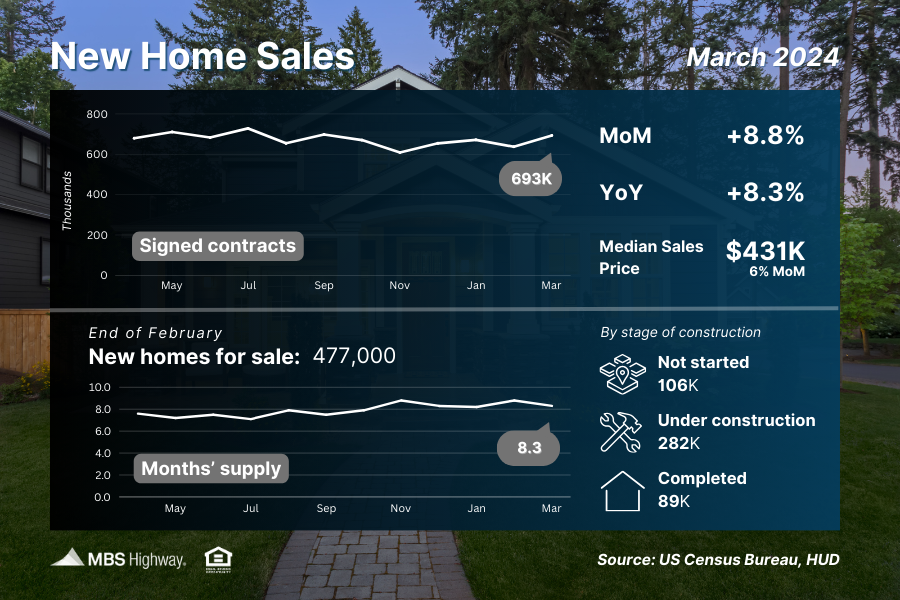Week of April 22, 2024 in Review
Inflation Progress Getting Harder:

March’s Personal Consumption Expenditures (PCE) showed that headline inflation rose
0.3% from February, with the year-over-year reading up from 2.5% to 2.7%. Core PCE,
the Fed’s preferred method which strips out volatile food and energy prices, also rose
by 0.3% monthly. The year-over-year reading held steady at 2.8%, stalling progress
toward the Fed’s 2% target.
What’s the bottom line? The Fed has been working hard to tame inflation, hiking its
benchmark Fed Funds Rate (which is the overnight borrowing rate for banks) eleven
times between March 2022 and July 2023. These hikes were designed to slow the
economy by making borrowing more expensive, lowering the demand for goods, and
thereby reducing pricing pressure and inflation.
The Fed has held rates steady since last September because inflation had been
showing good progress lower before stalling in more recent reports. At their meeting in
March, the Fed still signaled that three rate cuts are ahead this year. Will they change
their tune at their meeting this week? We’ll find out on Wednesday with their Monetary
Policy Statement and press conference.
New Home Sales Data Confuses Media

After falling in February, signed contracts on new homes rebounded 8.8% in March to a
693,000-unit annualized pace, reaching their highest level since September. Sales were
also 8.3% higher than a year earlier, as the persistent shortage of previously owned
homes for sale continues to fuel demand for new construction.
What’s the bottom line? Despite the strong headline figure, some media pundits
pointed to the decline in the median sales price, which was down nearly 2% from a year
ago, to say the report was a miss. But the median sales price did not decline because of
falling home prices (which continue to rise per Case-Shiller and other indexes), or a
growing number of price cuts from builders. In fact, 36% of builders reported cutting
prices in December, versus just 24% in March and 22% in April per the National
Association of Home Builders.
The median sales price represents the mid-price of sales, meaning it’s influenced by the
mix of sales in any given month. March’s decline in the median sales price stems from
the sale of more homes at lower price points. Builders are constructing smaller, more
affordable homes to meet buyer demand, and that pushed the median sales price lower
comparatively.
Signed Contracts on Existing Homes March Higher

Pending Home Sales rose 3.4% from February to March per the National Association of
REALTORS (NAR), coming in well above estimates. This report measures signed
contracts on existing homes, making it an important forward-looking indicator for
closings on these homes, which are measured in the Existing Home Sales report.
What’s the bottom line? The Pending Home Sales index hit its highest level in a year,
showing that activity is picking up heading into the spring homebuying season. An
increase in inventory and eventual decline in mortgage rates will only boost these sales
figures, with NAR’s Chief Economist, Lawrence Yun, noting, “Inventory will grow
steadily from more home construction, and various life-changing events will require
people to trade up, trade down or move to another location.”
First Quarter GDP Weaker Than Expected
The first reading of first quarter 2024 Gross Domestic Product (GDP) showed that the
U.S. economy grew by 1.6%. This was well below both the 2.5% estimate and the 3.4%
growth seen in the fourth quarter of last year.
What’s the bottom line? Slower economic growth is typically good news for the bond
market, but the hotter than expected inflation component within the report led to a sell-
off when the data was reported last Thursday. Note that this data is subject to revision
when the second and final readings are released on May 30 and June 27, respectively.
However, the weaker than expected initial reading is disappointing given that GDP
functions as a scorecard for the country’s economic health.
Initial Jobless Claims Hit 9-Week Low
Initial Jobless Claims fell by 5,000 in the latest week, as another 207,000 people filed
for unemployment benefits for the first time. Continuing Claims also declined by 15,000,
with 1.781 million people still receiving benefits after filing their initial claim.
What’s the bottom line? The low level of Initial Jobless Claims suggests that
employers are still trying to hold on to their workers. Yet, Continuing Claims are still
trending near some of the hottest levels we’ve seen in recent years, as challenges
remain for job seekers searching for their next position.
What to Look for This Week
Housing and labor sector data will share headlines with the Fed, starting Tuesday with
appreciation data for February from Case-Shiller and the Federal Housing Finance
Agency. We’ll also see updates on job openings and private payrolls (Wednesday),
unemployment claims (Thursday), and nonfarm payrolls and the unemployment rate
(Friday).
The Fed’s meeting begins Tuesday, with their Monetary Policy Statement and press
conference coming on Wednesday. Investors will be closely listening for news regarding
the timing of rate cuts later this year.
Technical Picture
Mortgage Bonds continue to trade in a wide range between support at 98.867 and
overhead resistance at 99.647. The 10-year retreated from the yearly high it reached
last Thursday, and there is room for yields to improve and move lower if we receive
some Bond-friendly news this week.



